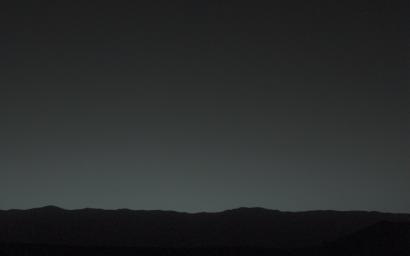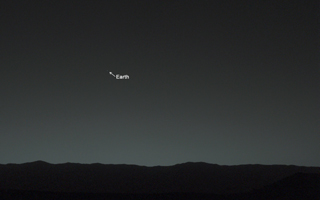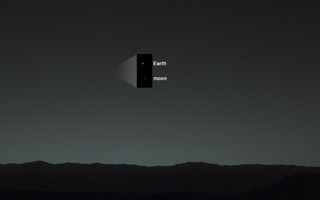
|
Bright ‘Evening Star’ Seen from Mars is Earth
- Click the image above for a larger view
- Full-Res JPEG (3200 x 2000) (389.6 kB)
- Full-Res TIFF (3200 x 2000) (19.2 MB)
Caption:
|
Click on an individual image for full resolution figures image
This view of the twilight sky and Martian horizon taken by NASA’s Curiosity Mars rover includes Earth as the brightest point of light in the night sky. Earth is a little left of center in the image, and our moon is just below Earth. Two annotated versions of this image are also available in Figures 1 and 2.
Researchers used the left eye camera of Curiosity's Mast Camera (Mastcam) to capture this scene about 80 minutes after sunset on the 529th Martian day, or sol, of the rover's work on Mars (Jan. 31, 2014). The image has been processed to remove effects of cosmic rays.
A human observer with normal vision, if standing on Mars, could easily see Earth and the moon as two distinct, bright "evening stars."
The distance between Earth and Mars when Curiosity took the photo was about 99 million miles (160 million kilometers).
Background Info:
NASA's Jet Propulsion Laboratory, a division of the California Institute of Technology, Pasadena, manages the Mars Science Laboratory Project for NASA's Science Mission Directorate, Washington. JPL designed and built the project's Curiosity rover. Malin Space Science Systems, San Diego, built and operates the rover's Mastcam.
More information about Curiosity is online at http://www.nasa.gov/msl and http://mars.jpl.nasa.gov/msl/ .
Cataloging Keywords:
| Name | Value | Additional Values |
|---|---|---|
| Target | Earth | Mars |
| System | ||
| Target Type | Planet | |
| Mission | Mars Science Laboratory (MSL) | |
| Instrument Host | Curiosity Rover | |
| Host Type | Rover | |
| Instrument | Mast Camera (MastCam) | |
| Detector | ||
| Extra Keywords | Color, Moon | |
| Acquisition Date | ||
| Release Date | 2014-02-06 | |
| Date in Caption | 2014-01-31 | |
| Image Credit | NASA/JPL-Caltech/MSSS/TAMU | |
| Source | photojournal.jpl.nasa.gov/catalog/PIA17936 | |
| Identifier | PIA17936 | |


